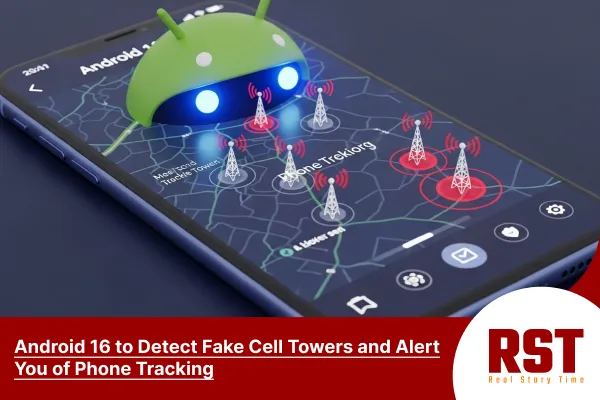Android 16 to Detect Fake Cell Towers and Alert You of Phone Tracking
By Anjana Chaudhary - Jul 12, 2025 | Updated: July 12, 2025 | 4 min read

One of the serious mobile phone security threats endangering the privacy of our communication is the increasing menace of spoofed (fake) cell towers. Spoofed cell towers, also known as “stingrays,” operate by masquerading as legitimate networks and secretly intercept our phone calls, data, and GPS coordinates whenever we inadvertently access them. This makes it difficult to detect fake cell towers.
Google has stated that Android 16 will leverage a new security feature to detect fake cell towers and send us an alert during an unusual connection.
The new detection capability marks a crucial step forward in countering IMSI catcher attacks and other forms of cellular interception. By introducing the ability to check for spoofed cell towers within the operating system, Google enables customers to use the privacy protection features they need.
The patch will prevent tracking by questionable third parties. That is a real help in keeping Android devices secure against more powerful interception capabilities.
The Threat of Fake Cell Towers (Stingrays)
Fake cell towers, also known as stingrays or IMSI catchers, trick people into connecting their phones to their towers by broadcasting a powerful signal. They exploit 2G network vulnerabilities and intercept calls, text messages, and GPS-based location data using IMEI numbers.
Stingrays, used by law enforcement, have also been employed by hackers and criminals for spying. Fake cell towers provide criminals with large targets. These devices, when detectable, can track legitimate or nefarious activities, making them powerful and undetected to the user.
Users are often unaware that their phones tend to connect to stronger signals by default. Criminals can exploit this vulnerability through Stingray devices and broadcasting fake cell signals, leading to the creation of a stronger fake network than legitimate towers.
The New Android 16 Security Feature
Android 16 offers a cutting-edge real-time Stingray detection technique by monitoring the behavior of the cell tower for abnormalities. The system examines signal qualities and identifies network anomalies that may denote likely attempts at spoofing. Android users are instantly notified of possible surveillance threats as soon as detection is achieved.
It uses various advanced baseband security and machine learning algorithms to detect fake cell towers around the area. It removes forced 2G downgrade attacks and operates autonomously in the background.
The new functionality is Android’s first native defense against IMSI catchers, somewhat closing a vital security gap in its ecosystem. It does not, however, render such attacks a thing of the past. It also complements other existing safeguards, such as encrypted messaging and guarding the underlying network connection.
READ MORE: Swami Anand Arhat: Spiritual Wisdom on Compassion, Success, and Inner Balance
Why 2G Networks Are Still a Risk
The antiquated encryption used by 2G networks (GSM A5/1) can be easily hacked in a matter of seconds. This allows a criminal to eavesdrop on personal calls or texts. Existing 4G/5G call apps and texting applications use mutual authentication to protect your calls and texts.
Conversely, 2G lacks tower authentication. Nothing stops a Stingray from masquerading as a legitimate cell tower. The flaw has yet to be resolved as many countries deploy 2G networks that are compatible with legacy devices.
Consequently, the reconnaissance that a Stingray provides is simple; it utilizes a design flaw of smartphones that automatically connect the device to the strongest signal, whether on an unsecured and untrusted 2G network. Since 2G networks exist for IoT devices and 911 purposes, they are ubiquitous, and creating a proposal for high-traffic areas is plentiful.
Conclusion: A Critical Step Toward Cellular Security
Google’s latest patch for Android 16 addresses the Stingray issue in terms of mobile security. According to Google, the security upgrade would improve mobile security by identifying phony cell towers and fixing a flaw that has permitted illegal monitoring of all cellular communications since the 2G period.
Android 16 introduces a new detection system that prioritizes security by providing users to detect fake cell towers and perceived threats, allowing immediate defensive action such as changing locations or turning off vulnerable network modes.
The update enhances mobile security, but 2G infrastructure risks persist until carriers complete the sunset of the network. The solution allows compatibility with robust security, a challenge that will evolve with 5G and future network standards.
Notice an error?
Help us improve by submitting a correction.







